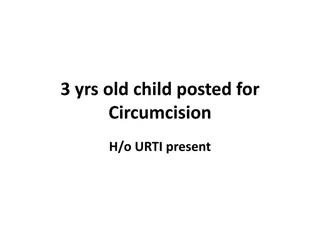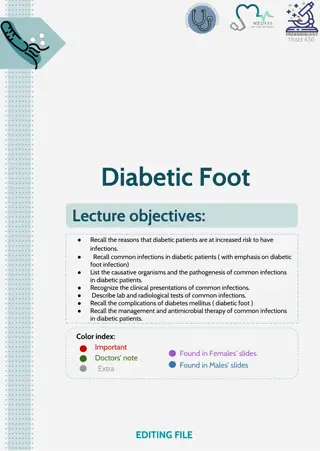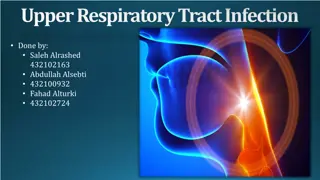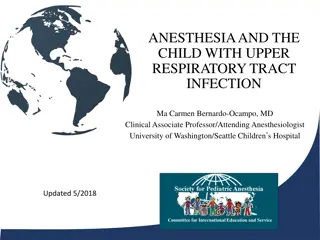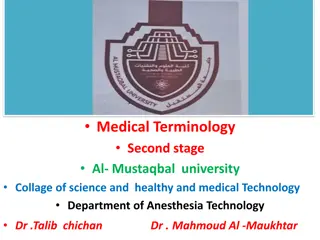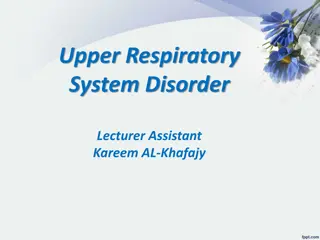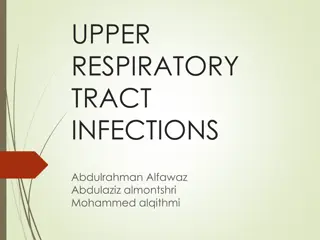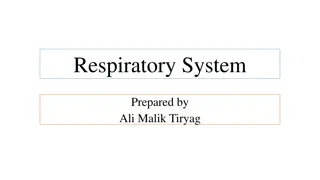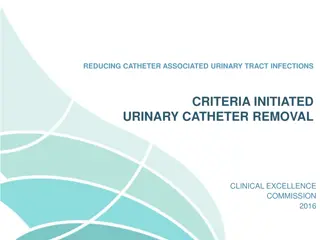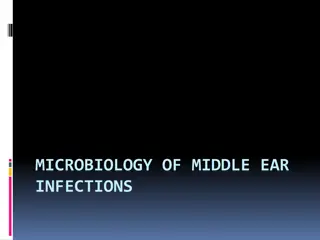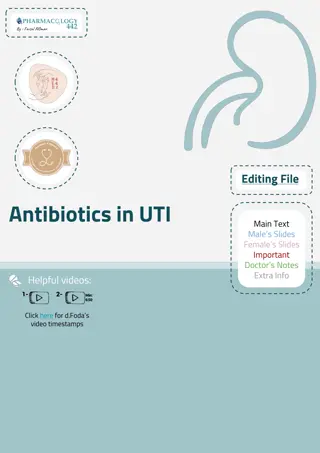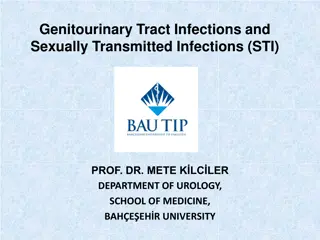Understanding Upper Respiratory Tract Infections (URTI) in Children
This informative lecture covers the epidemiology, clinical presentations, common etiological agents, and laboratory diagnosis of upper respiratory tract infections (URTI) in children. Topics discussed include pharyngitis, diphtheria, epiglottitis, pertussis, acute otitis media, sinusitis, and other related infections. Detailed insights on the signs, symptoms, diagnostic methods, and treatment options for each condition are provided.
Uploaded on Sep 14, 2024 | 0 Views
Download Presentation

Please find below an Image/Link to download the presentation.
The content on the website is provided AS IS for your information and personal use only. It may not be sold, licensed, or shared on other websites without obtaining consent from the author. Download presentation by click this link. If you encounter any issues during the download, it is possible that the publisher has removed the file from their server.
E N D
Presentation Transcript
Lecture : Upper Respiratory Tract Infection (URTI) important Extra notes Doctors notes " " .
Objectives: To learn the epidemiology and various clinical presentation of URT To identify the common etiological agents causing these syndromes To study the laboratory diagnosis of these syndromes To determine the antibiotic of choice for treatment
Overview of the lecture : File:Illu conducting passages.jpg 1- Pharyngitis 2- Diphtheria 3- Epiglottitis 4- Pertussis 5- Acute otitis media 6- Sinusitis (acute chronic) 7- Deep neck infection -read only 8- Other infections -read only
Pharyngitis: Common in children (5-15) Epidemiology Occurs in late fall ,winter and early spring Erythema Edema Exudate (sometimes) Signs & symptoms Remember 4 E s Enlargement >1 cm and tender of lymph node Fever 38.4 to 39.4 C or even 40 C. + Sore throat No signs and symptoms of viral infections : Mass of cells and fluid that has seeped out of blood vessels or an organ which is filled with protients, especially in inflammation : : redness
Pharyngitis: swap is taken Nasopharyngeal Viral infection (most common) Respiratory viruses : Enterovirus, HSV, EBV, HIV Etiology Antistreptolysin O (ASO) Culture RapidBacterial antigen detection. Group A strept (also called pyrogen!) Group A streptococcus, diagnose by Neisseria gonorrhoeae Anaerobic bacteria (Causes Lemierre's syndrome ) Corynebacterium diphtheria (normal flora) Bacterialinfection When it s a bacteria infection : (fever + sore throat BUT NO runny nose (no upper symptoms) swap taken from throat except Corynebacterium diphtheriae from Nasopharyngeal!!! children more susceptible because they have large lymph nodes .: A complication of a bacterial sore throat. : A test that measures antibodies against streptolysin O.
* Diphtheria common cause of death on non-vaccinated children 1-5 years. Epidemiology Toxin mediated disease . Rapid progression Pathogenesis Tightly adhering grey membrane in the throat .. difficulty breathing and swelling and cause suffocation and death Etiology Corynebacterium diphtheriae Tinsdale medium Diagnosis ELIK s Test for confirmation Penicillin Treatment Erythromycin if the child is allergic to Penicillin :TinsdaleAgar used to identify C. diphtheria :Test for toxigenicity of C. diphtheria :symptoms : sore throat, difficultyin breathing, swallowing,drooling (( of saliva. The membrane can get bigger until it obstructsthe airway causing suffocation( ),death : The bacteria will produce toxinsmove from throatand affect other organs usually heart and the peripheral nerves and sometimesthe adrenal glands
Epiglottitis: Epidemiology Affects young unimmunized children Signs and symptoms Usually presented with three D s: 1-Dysphagia (difficulty or discomfort in swallowing) 2-Drooling (dropping saliva uncontrollably from the mouth) 3-distress (anxiety) Etiology Bacteria Fungal Viral Haemophilus influenza Type b Streptococcus pneumoniae Staphylococcus aureus Beta hemolytic streptococcus Candida Treatment Crftriaxone normal can't see with X-ray X-Ray = thumb sign Don't try examine airway by opening mouth --> suffocation and death! Instead diagnose with X-ray throat swap patient will be leaning forward, open mouth, difficulty swelling Type B is encapsulated so it can invade the blood, we also used the capsule to develop the the vaccine against this bacteria.
Pertussis (whopping cough ): Etiology : Caused by Bordetella pertussis (gram ve) Pathogenesis: the bacteria attaches to the cilia of the respiratory epithelium, then produce (pertussis toxin) that will cause inflammation to the respiratory tract and interferes with the pulmonary secretions, it also produce Filamentous hemagglutinin (FHA) and Pertacin (PRN), these products responsible for the clinical features. Causes leukocytosis with lymphocyte predominance (it is the only bacterial infection that causes lymphocytosis in this lectuere) Clinical Course Incubation period 1 to 3 wks Catarrhal Stage 1-2 weeks Paroxysmal Stage 1-6 weeks Convalescent Stage 3-6 weeks Diagnosis: nasopharyngeal swabs (NB), the swab is cultured in a special media called Charcoal-horse blood T media (regan-lowe) bordetella selectve media (bordet-gengou) Treatment : Erythromycin Prevention : By vaccination *pertactin: highly immunogenic virulence factor of Bordetella pertussis. Children = cyanosis because they have small trachea and increased mucus Adult = chronic cough *Hemagglutinin :Large, filamentous protein that gives attachment factor for adherence to host ciliated epithelial cells. Thanks for 435 team
Acute otitis media: Secondary bacterial infection Streptococcus pneumoniae. Haemophilus influenzae. Group A streptococcus (GAS ) Staphylococcus aureus.(S.aureus) Moraxella catarrhalis. Viral and Fungal too. Etiology Tympanocentesis (Drainage of fluid from the middle ear) Diagnosis Amoxicillin o r AMC (Amoxicillin + clavulanate). If mastoiditis (Inflammation of the mastoid process ), treat for 2 weeks. Treatment middle ear causing the infection and inflammation of the middle ear. In the sever cases the middle ear can rupture and cause the fluid or pus to come out. It s caused by the stagnant accumulation of contaminated fluid coming from the Nasopharynx into the 9
Bacterial Bacterial sinusitis: sinusitis:usually self limiting Acute sinusitis Chronic sinusitis Children 13% of cases Etiology viral S.pneumonia H.infuenza M.catarrhalis S.pneumonia H.infuenza M.Catarrhalis Oral anaerobes Etiology (Bacterial ) Mimic allergic rhinitis. Less local symptoms Signs and symptoms Mainly clinical diagnosis Aspiration in case Immunocompramized , treatment failure Diagnosis X-rays CT/MRI Periorbital cellulitis R/O sinusitis by CT/MRI Post-septal involvement treat as meningitis. Obtain odontogenic (1)X-rays if maxillary sinus (2). Dx Image less useful than acute (changes persist after Treatment and to R/O tumor) Diagnosis Quinolones or Ceftriaxone For 1-2 weeks. Quinolones or Ceftriaxone (For 2-4 weeks) treatment (1) Tooth or the closely surrounding tissues. (2) The maxillary sinus is one of the four paranasal sinuses, which are sinuses located near the nose. 10
Deep neck space infections: ( (Usually a complication of another infection and is very rare nowadays Usually a complication of another infection and is very rare nowadays) ) Lateral pharyngeal, retropharyngeal or prevertebral space. Patients are toxic with unilateral posterior pharyngeal soft tissue mass on oral exam. Neck stiffness with retropharyngeal space infection/abscess. Retropharyngeal (danger space) infection may extend to mediastinum and present a mediastinitis. Prognosis is poor if surgical drainage has not been done. Etiololgy : Usually the pathogens that cause Deep Neck Space infections are Streptococci and Anaerobes. Treatment: Meropenem or Piperacillin or Clindamycin for 2 weeks(All of these antibiotics cover Anaerobes). antibiotics cover Anaerobes). (All of these You can read this slide
Other infections: Lemierre's Syndrome: It is a complication of a peritonsillar abscess (It generally involves a pus-filled pocket that forms near one of your tonsils) or a postdental infection. Clinical Presentation: Sore Throat, Fever, Shock. The presenting symptoms are due to IJV(Internal jugular vein) *thrombophlebitis which leads to multiple septic emboli in the lung (a blood clot, fat globule, gas bubble or foreign material in the bloodstream that is caused by bacteria). It is caused by Fusobacterium Necrophorum Treatment is the same as Deep Neck Space infection. Meropenem or Piperacillin or Clindamycin for 2 weeks, If the patient does not respond to the treatment, venotomy must be done. (This can go the the internal jugular vein and cause an infection and will create a thrombosis that will ultimately end up in the lung causing the pulmonary embolism. It s diagnosed by X-ray) *thrombophlebitis : Inflammation of the wall of a vein with associated thrombosis) You can read this slide
Name diagnose Etiology Treatment Pharyngitis 1.Antistreptolysin O (ASO) 2.Culture 3.Rapid Bacterial antigen detection. Viral (most common): 1-Enterovirus 3-EBV 4-HIV Bacterial: 1.Group A streptococcus 2.Neisseria gonorrhoeae 3.Anaerobic bacteria 4.Corynebacteriumdiphtheria - 2-HSV Diphtheria 1-Tinsdale medium 2-ELIK s Test -Penicillin -Erythromycin Corynebacterium diphtheriae Epiglottitis - Fungal: Candida Bacteria: 1.H. influenza Type b 2.S. pneumoniae 3.S. aureus 4.Beta hemolytic streptococcus Viral Crftriaxone Pertussis nasopharyngeal swabs -Charcoal-horse blood T media -bordetella selectve media Bordetella pertussis Erythromycin Acute otitis media Bacteria S. pneumoniae. H. influenzae. Group A streptococcus (GAS ) S.aureus Moraxella catarrhalis. Tympano centesis Viral and Fungal. -Amoxicillin -AMC (Amoxicillin + clavulanate). Acute sinusitis Bacteria: 1- S.pneumonia 2- H.infuenza 3- M.Catarrhalis -Aspiration (Immunocompramized) -radiological Viral 13% of cases Quinolones or Ceftriaxone Chronic sinusitis -odontogenic -X-rays (maxillary sinus) 1- S.pneumonia 2- H.infuenza 3- M.Catarrhalis 4- Oral anaerobes
SAQ: An unvaccinated child with cough who seems to be gasping for a breath and makes a whooping sound. After taking a swab and under the microscope we found gram negative bacilli. We did the culture in blood agar and it was negative for that. Later with further investigation we found that the patient has Leukocytosis especially the lymphocytes. Q1: What is the most likely diagnose in this case ? Pertussis (Whooping cough) Q2: What is the most likely bacteria can cause that ? Bordetella pertussis Q3: List three virulence factors does this bacteria have : Pertussis toxin Filamentous hemagglutinin Pertactin Q4: Is there any culture media or agar you suggest it to confirm your diagnose ? Bordet Gengou agar. Q5: From where do you think the swab was taken ? Nasopharyngeal. Q6: Which antibiotic can be used as a treatment or even prophylaxis in this case ? Erythromycin Q7:This infection can be prevented by vaccine such as DPT. What are the other infections/disease can be prevented with the same vaccin ? D for Diphtheria P for Pertussis T for tetanus
SAQ: A 5 year-old suddenly complains of sore throat, malaise, and low grade fever. Examination reveals a white\grey thick coating of the tonsils, uvula, and palate. It cause sudden bleeding when we tried to scrape this coating. Q1: What is the most likely diagnose in this case ? Diphtheria Q2: What is the most likely bacteria can cause that ? Corynebacterium diphtheriae Q3: Which agar can help us to identify this organism ? Tinsdale agar Q4: Is there any test for toxigenicity can be used in this case ? ELIK s Test. Q5:How can be treatment ? Anti-toxin Penicillin Erythromycin if there is allergy from penicillin ( 5 , Tinsdale medium ELIK s Test ) ( , .) https://www.onlineexambuilder.com/micro-uri/exam-131908 MCQs:
GOOD LUCK! MICROBIOLOGY TEAM: Waleed Aljamal (leader) Ibraheem Aldeeri Ibrahim Fetyani Abdulaziz almohammed Abdulmalik alghannam Omar albabtain Turki maddi Mohammad alkahil Meshal Eiaidi Khalid Alhusainan Khalid Alshehri Nasir Aldosarie Shrooq Alsomali and Ghadah Almazrou (leaders) Rawan Alqahtani Dorah Alhamdi The Editing File We are waiting for your feedback @microbio436 436microbiologyteam@gmail.com


